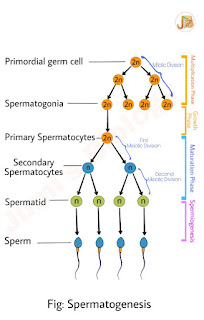Menstrual Cycle: Human Reproduction ||Class 12 Biology
The menstrual cycle is the regular natural change that occurs in the female reproductive system that makes pregnancy possible. It is known as the cyclical reproductive events in females of all primates, i.e. monkey, apes and human beings. The first menstruation begins at puberty and is called menarche. In human females, menstruation is repeated at an average interval of about 28-29 days. The menstrual cycle stops at around 50 years of age, termed as menopause. The cyclic menstruation is an indication of normal reproductive phase and continues between menarche and menopause.
The menstrual cycle consist of following four phases:
1. Menstrual phase
2. Follicular or Proliferative phase
3. Ovulatory phase
4. Luteal phase
1. Menstrual phase: The cycle starts with this phase which last for about 4 days. It involves the following main events-
• Reduction of LH level causes regression of corpus luteum and a consequent fall in the progesterone level in the blood.
• The uterine lining dies due to the deficiency of progesterone and sloughed off. Blood vessels rupture forming a liquid which along with unfertilized ovum comes out through the vagina. The process is called menstruation. It only occurs if fertilization does not takes place.
2. Follicular or Proliferative phase: This phase lasts for about 14 days and involves the following main events-
• The FSH and LH levels increases gradually during this phase and stimulates the growth of the selected primary ovarian follicle and maturation of the primary oocyte into it.
• The primary follicle consists of a primary oocyte surrounded by a single layer of cells, the follicle epithelium.
• A fluid-filled cavity called follicular cavity appears in the greater part of the follicle. The follicle is when mature and called Graafian follicle. Simultaneously, the endometrium of uterus regenerate through proliferation.
• The growing follicles secret estrogens.
3. Ovulatory phase: This phase lasts about one day (14th) and involves following main events-
• Both FSH and LH attains a peak level in the middle of cycle.
• Rapid secretion of LH leading to its maximum level during the mid-cycle called LH surge. It induces rupture of Graafian follicle and thereby the release of ovum, i.e. ovulation.
• The ovulation (ovulatory phase) is followed by luteal phase.
4. Luteal phase: This phase lasts for about 10 days and involves the following main events-
• The remaining part of Graafian follicle transforms as the corpus luteum.
• The peak of LH, together with prolactin hormone from anterior pituitary stimulates the follicular cells of the empty Graafian follicle to form corpus luteum.
• The corpus luteum secrets large amount of progesterone which is essential to maintain endometrium.
• The endometrium is necessary for implantation of the fertilized ovum and other events of pregnancy like formation of placenta. During pregnancy, all events of the menstrual cycle stop. In the absence of fertilization, the corpus luteum degenerate.
• This causes disintegration of endometrium leading to the menstruation and a new cycle starts.



Comments
Post a Comment
If you have any doubts,please let me know